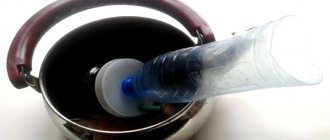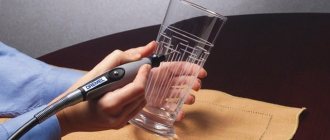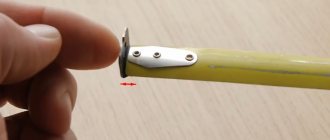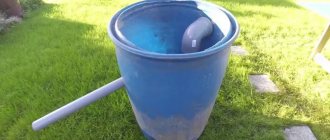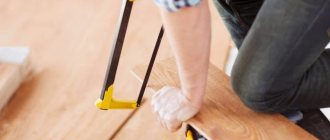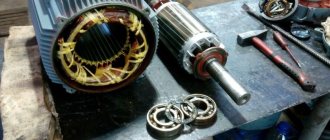In modern practice of repair, construction and various types of household work, the grinder is very popular. With its help, you can perform many cutting, grinding, and stripping operations, but you also need to know how to use it correctly. Let's look at which direction the grinder should turn, what it is, what its application is, rules for selection and safety precautions, what rules should be followed when working with it, and also how to properly unscrew the nut to change the disc.
The grinder is convenient and practical in everyday life, however, subject to strict adherence to safety precautions Source stroy-podskazka.ru
What is causing the problem?
When rotating at idle, it is difficult to encounter a similar problem. Especially when working with light wheels and tools with a soft start function. However, after increasing speed and contact with the surface being cut, the following occurs:
- When material resistance occurs at the wheel, the angular speed of rotation sharply decreases and it slows down.
- The engine, by inertia, continues to operate for several moments at the same speed, dragging the gearbox and spindle with it.
- The locking nut is tightened by inertia more strongly along the threads of the spindle head, thereby pressing in the cutting disc.
That's it, the process of tightening the fixing flange is completed - an emergency situation is obvious. The following factors influence its occurrence:
- Large circle size.
- High power of the tool.
- Massiveness of the rotor.
- A sharp increase in cutting depth, i.e. increase in resistance.
In this case, removing the disc from the grinder can be very difficult. Additional measures need to be taken.
Replacing a disk in normal mode
When operating an angle grinder regularly, you need to constantly change the wheels, which are consumables. If the tool is no longer comfortable to work with, then the worn abrasive wheel should be replaced.
Important! Be sure to check the electrical disconnection to avoid personal injury.
Step-by-step algorithm of actions
The circle is secured to the spindle head with a locking nut having an M14 thread. The standard configuration includes an open-end wrench with special protrusions for engaging with the holes of the fixing flange.
To unscrew the nut, you need to fix the spindle. For these purposes, there is a special lock located on the back of the angle grinder. By pressing the button, you will secure the gearbox with a cotter pin, eliminating the possibility of its rotation.
Insert the key into the holes. Hold the latch with one hand, and with the other turn the wrench counterclockwise, moving the nut.
The direction of movement of the disk is usually clockwise. However, there are models that may have something different. In any case, unscrewing occurs in the opposite direction to rotation.
Once the nut is in place, it can be unscrewed by hand without any effort.
Remove the retainer and the old circle.
Remove the bottom flange.
After intensive work with a tool with metal inside the casing, you can find a layer of burnt scale with abrasive. Use a steel brush to remove residue.
After cleaning, install the lower flange in place, aligning the grooves of the spindle with the grooves of the flange. A gasket is placed on top.
If your model does not have additional spacers, then such washers can be prepared from plastic or thick cardboard. Next, you need to correctly place the disc on the grinder and cover it with a similar gasket.
Important! Installed spacers allow you to easily unscrew the nut, even if the disc is pinched or broken.
Use your hand to tighten the top clamp counterclockwise (counter-rotation), supporting the cutting wheel. In this case, you also need to tighten the spindle lock and tighten the flange until there is noticeable resistance. Use the open-end wrench to tighten it with a little more effort. Do not over-tighten the fastener, otherwise you can overtighten the circle and it will warp.
Now you can continue to work. However, problems arise from time to time and it is simply impossible to unscrew the disc on an angle grinder. Let's see below how to change the disc on an angle grinder in such cases.
What to do if you bite the nut on an angle grinder
A grinder is a fairly popular tool that is often used in the household for sawing wood, metal or stone. When using these angle grinders for a long time, people often encounter the cutting disc jamming. This leads to the fact that the tool begins to work much worse. To cope with such a problem, you need to figure out in advance how to unscrew the nut on an angle grinder and what needs to be done for this.
A grinder is a power tool often used for sawing various materials.
The nut is stuck - how to unscrew it?
Removing a disc on an angle grinder if it is bitten is not so easy, especially without damaging the cutting element or tool. We will also consider several options for action.
Replacing a counter-rotating disc
This method has several advantages - it can be done without a key and with a broken spindle lock. Beginners in working with angle grinders mistakenly believe that if the stopper breaks, it is almost impossible to unscrew the nut. However, this is not the case. You don't even need keys.
The point is that the abrasive wheel needs to be rotated in different directions. Wearing thick gloves, you need to hit the cutting edge of the circle several times. This is what will ensure variable movement in different directions. As a rule, a couple of sharp blows are enough so that the nut can be easily unscrewed.
Read also: Reasons for decommissioning a lathe
Open-end wrench and socket head
In this case, you will have to slightly modify the existing standard tools - a 17 mm open-end wrench and a 24 mm socket. The thickness of the key is ground down to 4 mm. 4 protrusions are machined on the head and fit into the holes of the retaining nut.
After preparation, the key is placed in the space under the disk, and the head is put on the flange of the angle grinder and rotated in the direction opposite to the rotation of the wheel. After this, you can easily remove it and install a new one.
Heat
This is one way to remove a disc from an angle grinder without a key. The fixing nut is heated with an industrial hair dryer or a gas burner. After this, the flange will unscrew much easier. However, there is a risk of damage to the plastic parts of the angle grinder or gearbox.
With a nail
For these purposes, a 100 mm nail is best suited. It should be bent into a U-shape so that the ends fit freely into the holes of the clamping flange. The tip and cap are removed. By inserting a nail into the holes, the latch is unscrewed. If the manual effort is not enough, then add a nail or screwdriver in the form of a lever.
Using a gas wrench
The use of this tool is justified by an increase in the applied moment of force due to the increased arm. Using a gas wrench will make it much easier to unscrew a jammed connection. However, when eliminating snagging, it is important to remember that if you apply excessive force, there is a risk of damaging the spindle lock or clamping nut.
Using a rotary hammer or drill in chiselling mode
You can unscrew the disc on an angle grinder without a key using a drill or hammer drill, having first switched it to jackhammer mode. A suitable drill, most often 6 millimeters, is used as a working attachment. Place the drill against the edge of the hole in the clamping nut, fix the movement of the spindle and briefly turn it on to move it from place. This method allows you to turn away even very complex snacks.
Tapping the nut
This method is similar to the previous one, only you can use a suitable metal rod or chisel. Having fixed the spindle head, tap along the edges of the clamp holes in the direction of movement of the wheel. By slightly moving the lock from its dead point, you can unscrew it by hand. However, the method is not the most harmless for the tool - the mounting holes for a standard key are damaged.
Cutting wheel destruction
You can unscrew a jammed nut by completely destroying the disk. If there is already damage, you can break it off with your hands, but most often this will not be possible. It’s better to take a hacksaw or metal blade and cut it. This will leave you with a center ring and hard-to-reach pieces. Having found a suitable plate, holding it in a vice, grind off the remaining abrasive on it to a metal ring. After this, it will be easily unscrewed with a standard key.
The most radical way to unscrew a jammed clamp nut is to cut it. It is advisable to resort to it only in extreme cases. Of course, you can find a new one, but you will have to spend your time and money. It is not uncommon for spare clamping elements to be included in the delivery set of an angle grinder.
The disk is bitten, how to remove the clamp
You can loosen a clamped threaded connection by heating the clamping nut by friction against the wooden surface of a thick beam or the stump of a tree cut down at the dacha. Unlike heating with a blowtorch or gas torch, here it is possible to regulate the force of pressing the nut against the wood. More uniform heating of the threaded connection for several minutes makes this method less safe in terms of maintaining the functionality of the angle grinder. In practice, as shown in the following video, the clamping nut will easily unscrew when it reaches a temperature at which a drop of water will instantly evaporate after it hits the surface of the angle grinder’s clamping nut, heated by friction.
How to install the disk correctly, do you need to tighten it?
While the grinder is working, the clamping device pressing the disc tends to tighten even more. Therefore, when installing a new consumable, you only need to lightly tighten it. Further, the laws of physics will provide him with a reliable clamping of the tool.
Measures to prevent jamming
By taking care of the safe operation of the angle grinder in advance, you will save yourself from the need to take measures to eliminate an emergency situation. Such events include:
- Place cardboard or plastic washers between the disk, flange and spindle head. They do not allow the tool to jam, but even in the event of a corkscrew, they can be removed/melted and the element can be easily unscrewed.
- The abrasive wheel must be installed correctly. To do this, place the front side of the circle on the support flange (with the picture facing the gearbox). It should not come into contact with the clamping nut. In this case, the standard metal ring in the center will act as a washer preventing jamming.
- Weld a regular nut onto the clamping flange, which allows you to press the installed disk using a regular wrench.
- Check the tightening force. No excessive effort is required to install the cutting element. Otherwise, it will jam under intense loads.
Which way to unscrew the disc on an angle grinder?
Nowadays, almost everyone who loves and knows how to make things has a tool such as a grinder at home. The correct name for this tool is an angle grinder (angle grinder). It is called the Bulgarian because the first mechanisms of this type were brought to the Soviet Union from Bulgaria.
In its classic version, an angle grinder is a hand-held power tool with an abrasive wheel for processing the joints of flat metal surfaces. But with the help of this simple mechanism you can also cut sheet metal, fittings, and ceramic tiles.
Safety regulations
When working with an angle grinder, it is important to remember that this tool has an increased risk of injury. Accordingly, you should not lose vigilance under any circumstances, even when disconnected from the power supply. When using auxiliary tools and materials to replace the disk, pay close attention to them. Plumber tools can also cause significant injury.
An angle grinder (angle grinder) or grinder has proven itself to be a very effective tool with which you can perform a wide range of work. However, during its operation, you should adhere to safety precautions, since the disk speeds are very high and you can get injured. Judging by numerous reviews, many home craftsmen have problems with the discs; they often split, and the nuts with which they are clamped become jammed. The reason for this may be the human factor or simply marriage. As a result, such a nozzle cannot be used for its intended purpose.
It would seem that there is nothing difficult about replacing the disk with a new one. However, at this stage the master is faced with a problem - the nozzle is tightly clamped by a fixing nut that does not want to unscrew. How to remove a jammed disc from an angle grinder? What methods are used for this? What means can be used if the standard key is lost? You will learn how to remove a jammed disc from an angle grinder from this article.
Read also: How to connect an airbrush to a regular compressor
Video description
Video advice on how to properly hold an angle grinder while working:
The problem can be solved with the following tricks:
- Overalls made of thick fabric reliably protect the operator from spark flow. Since the temperature of the sparks is low and does not cause much harm.
- A mask or goggles reliably protect your eyes and face from accidental sparks.
- The guard can direct the sparks so that they only fly downwards.
In the practice of working with a grinder, there are situations when the tool needs to be positioned so that the rotation of the circle is reversed to the safe position. In such a situation, the operator needs to use more reliable means of protection. However, the device should be used in this position in exceptional cases.
What is the cause of the problem?
Before asking how to remove a disc from an angle grinder, experts recommend understanding why the nut on an angle grinder bites. It has been noticed that this problem is mainly observed in angle grinders that have a significant disc size. A disc over 18 cm is considered large. During operation, torque is generated. Next, when the master begins cutting, a small impact occurs. In other words, a force is exerted on the disk. If the size of the nozzle is no more than 12 cm, then this impact will be insignificant. If the disk is large, then the nut is tightened more by inertia. As a result, it is not possible to dismantle it in the usual way. Read more about how to remove a disc from an angle grinder below.
How to unscrew it if it's tight?
First, let’s answer a common question: “In which direction does the nut on an angle grinder unscrew?”
Remember! You need to unscrew in the direction of rotation of the disk. Those. If the disk rotates clockwise, then you need to unscrew the nut clockwise.
The easiest way to unscrew the disk mount is to place a key and then hit it with a hammer several times with medium force.
If this does not help, there are alternative methods to solve the problem:
- heat the fastening mechanism with a torch, which will cause the metal to expand. As a result, the structure will become movable;
- Using a small metal plate, grind the disc down to the nut. Continue grinding until its surface comes into contact with the nut and begins to turn it;
- insert the steel pipe into the holes of the nut, use it as a lever to unscrew the tightened nut. Do not apply too much force so as not to break the thread;
- Lubricate the threads with machine oil, such as WD-40. Wait 3-5 minutes and then try to unscrew the fastener using a key. Using this method, you can also get rid of rust inside the landing shaft;
- If you need to remove a circle that has not been used for a long time, you can start tightening the fasteners even more tightly. After that, try to weaken it again;
- Boiled or rusted threads on angle grinders can be treated with turpentine, vinegar, white spirit or rust solvent. After processing, you need to wait at least 30 minutes and then try to unscrew the nut again.
If a situation arises where you are left without a key, you can cut off the stuck fastener with a chisel or grind it off with a second grinder with a metal disc. After this, you will have to restore the threads and also look for a spare nut. If the circle still doesn’t give in, you can try combining different methods. For example, treat the shaft with machine oil, and then begin to unscrew the nozzle using a lever or tap the mechanism with a hammer.
Important! Do not unscrew the fastener with great force. This can lead not only to thread failure, but also to breakdown of the angle grinder body itself.
First way
How to remove a disc from an angle grinder if it is broken and tightly clamped with a clamping nut? Of course, you can try using a special wrench for angle grinders or a gas wrench. However, judging by the reviews, after making enormous efforts and wasting time, the master may not get the expected result. Dismantling can be easier and faster. To do this, use pliers to completely break the disk. Due to the fact that small fragments will fly away during the work, the technician will need protective glasses (mask) and gloves.
Then you need to take a metal plate, the thickness of which is less than that of the disk. With the help of this plate its remains will be ground off. To do this, you need to turn on the grinder and firmly clamp the metal piece with pliers. After completing these steps, the nut can be unscrewed even by hand.
How to install correctly?
Installing a disk on a UMS is not that difficult. You can change it simply by following the instructions, although there are some aspects to this.
First, you need to install the disk with the correct side. This is especially important if it is cut-off. Typically, the side of the disc with the label, which indicates the marking and, accordingly, the area of its implementation, is slightly different from the reverse side. This may not be revealed immediately, but with long-term intense work, the difference will not only be visible - it will be obvious.
On the side on which the label is glued, a wide pressure washer is placed; the moving nut will affect it when tightening (installing the disk). The nut slides along the polished surface of the washer; without it, tightening or unscrewing will become more difficult, because the abrasive will firmly hold the nut and more force will be needed. This is especially important if the disk needs to be quickly replaced or if it breaks (jammed).
There is always a chance of a disk breaking, but if installed correctly, it breaks only under enormous loads; the structure of the disks takes into account the difference in loads on both sides.
With circular saws or other products that have teeth or a significant difference between the two sides, the problem of how to set it usually does not arise. For example, it will not be possible to fasten a grinding disc opposite it: it will simply be impossible for it to work.
Stone discs, including diamond ones, have a special rotation indicator in the form of an arrow: when installing them, it is necessary to strengthen them, taking into account where the rod will rotate. When installing, it is also important to take into account the size of the disk.
Under no circumstances should you compromise safety and remove the protective casing - it is better to choose a disk of appropriate diameter. From time to time, a worn-out disc from a huge unit is placed on the smallest-sized grinder. But a worn-out disk usually cuts worse, the working surface is limited to approximately half the radius of the disk, and the structure is slightly different. The disk burns faster and produces less work. This operation can be justified if the diameter of the rod matches. But you can't change it back
When installing, it is also important to take into account the size of the disk. Under no circumstances should you compromise safety and remove the protective casing - it is better to choose a disk of appropriate diameter. From time to time, a worn-out disc from a huge unit is placed on the smallest-sized grinder. But a worn-out disk usually cuts worse, the working surface is limited to approximately half the radius of the disk, and the structure is slightly different. The disk burns faster and produces less work. This operation can be justified if the diameter of the rod matches. But you won’t be able to change it back.
When installing, no debris should get under the disk. Naturally, the pressing nut can completely squeeze out small objects, and some will be crushed into the surface of the circle. But a distortion that is not noticeable to the eye will cause a displacement of the plane of rotation and, as a result, strong vibration of the entire mechanism; it can become a prerequisite for the destruction of the disk and, naturally, in this case it is not worth relying on a clear cut.
Before installing the disk, the grinder must be disconnected from the network - this is a basic safety requirement, because turning it on unexpectedly at this time can result in serious injury.
The clamping nut must be unscrewed with the wrench supplied with the tool. To prevent the rod from turning, it must be locked by pressing a special button. It is necessary to unscrew the nut while simultaneously holding the button pressed.
After twisting the nut, a disk is put on the freed rod, face outward, and you need to make sure that it is installed exactly in the seating area.
The kit for the newest “grinder” always includes a certain number of cardboard spacers - when installing the disk, they must be laid so that they are between the disk and the pressing elements. Such gaskets will help unscrew a broken or jammed disk.
Next, the nut is manually tightened until it stops and tightened with a special wrench. That's it, the grinder is ready for work.
How to remove a disc from an angle grinder with a key?
If the special key that comes with the angle grinder is not lost, then the task will be easier to cope with. For those who are interested in how to remove a disc from an angle grinder, experts advise first of all to fix the spindle. It is on this that the disk is located and pressed using a flange. It is dismantled with an open-end wrench. To make this technically possible, the flanges are equipped with special holes into which the key pins are inserted.
To lock the spindle, you need to press the button, which is located on the body on the back side of the disk. While working with an open-end wrench, the lock must not be released, otherwise the spindle will continue to rotate. If the disc in the grinder rotates clockwise, the open-end wrench should be turned counterclockwise and vice versa. It is important that the flange gives way and moves out of place. Now you can unscrew it completely and put it aside. Then the old disk is removed and replaced with a new one.
The main question: How to choose the right disc for an angle grinder?
When choosing equipment for an angle grinder, first of all, you should decide on the type of work you intend to do. The choice of disk type will depend on this. We would also like to mention that when choosing a consumable, be sure to take into account the power characteristics of each specific model. Study the labeling. Often, it is printed on the disk itself and includes a set of symbols by which you can determine the relevance of a given consumable for performing the intended work.
Also, focus your attention on such a parameter as the diameter of the disk. In no case should it exceed the size of the protective casing on a specific tool model.
The size range of discs is usually represented by the following diameters: 115, 125, 150, 180 and 230 mm. The most common diameters are 125 mm. and 230 mm. They are optimal for most types of work and the capabilities of the tool itself.
As for the thickness of discs for metal and stone, it often varies from 1 to 3.0 mm. cutting discs). Based on the reviews of many craftsmen, we can conclude that the thinner the disk, the more convenient it is to work with it. This is, of course, true, but do not forget that when working with a disk of small thickness, its fragility increases and the risk of failure of the entire tool increases.
Among bakelite-based sanding discs, the most popular are those with a thickness of 6.00 mm. This parameter depends on the overall diameter of the disk. The relationship is as follows: the larger the diameter of the disk, the greater its thickness and vice versa.
How to remove without a key?
Judging by numerous reviews, the grinder disk can be dismantled using a large pipe wrench, which is popularly called a gas wrench. First of all, the master needs to spread it so that it can completely wrap around the flange. While turning the gas wrench with the flange clamped in it, the spindle is held by some metal object. According to reviews from home craftsmen, this method is considered very effective. If this does not help, then experts advise “tapping” the nut with a metal rod or a thin chisel. The spindle is also fixed. The nut will move if you lightly tap the flange at the very edge. Strikes should be made in the direction in which the disc is spinning. According to experienced craftsmen, this method cannot be called safe. The fact is that you can damage the flange, namely the holes into which the open-end wrench pins are inserted.
Rotary hammer or impact drill
To be honest, it is not the best or easiest option to unscrew a jammed nut on an angle grinder, but it is used if other methods do not work. As an attachment for a drill or hammer drill, you need a drill of a suitable diameter, most often 6 mm. If you are using a drill, you need to set it to jackhammer mode in advance. It is better to fix the grinder in a vice, clamp the spindle stopper, insert the drill into one of the holes of the clamping nut with emphasis in the direction of unscrewing, and briefly press the “Start” button. This method allows you to move even a tightly clamped flange. The disadvantage is that this can break the mounting holes for a standard key.
PHOTO: i.ytimg.com Insert the drill into one of the holes in the nut and turn on the drill in impact mode
Dismantling with a nail
Removing a damaged disk will not be difficult using a key made from a nail. According to experts, its optimal size is at least 100 mm. First, the nail needs to be bent into a U-shape. It is important that the distance between its ends corresponds to the two holes in the flange. Then, using a hacksaw from a weave, you need to carefully cut off the cap and tip. Now the homemade key can be inserted into the flange, fix the spindle and unscrew the mount. If it turns out that the nut is tightened very tightly, you will need a larger lever. You need to insert another “hundred” between the two vertical ends.
What else can you do?
If the above methods do not work, then the nut will have to be heated with a gas burner. Under the influence of high temperature, the nut will expand and begin to rotate. You can also use a rather barbaric method, namely sawing the nut with a hacksaw. Then you will have to buy a new one. Some technicians use WD-40 penetrating lubricant. It is used for processing threaded connections. Judging by the reviews, after just a few minutes the nut can be turned.
Main uses of angle grinders
- Cleaning surfaces, stripping off old paint. It is performed with brushes with steel rods or sandpaper petals. There are no difficulties in operation, except that brushes with sandpaper require compliance with the direction of rotation.
- Sanding with sandpaper. A concentric attachment with Velcro is screwed onto the grinder, onto which the abrasive in turn is attached. Before use, check that the direction of the threaded fastening and the rotation of the tool shaft are consistent.
- Grinding with abrasive wheels. These attachments require careful handling, as under high load, the abrasive may break. You cannot cut material with such discs; shock loads are unacceptable.
- Cutting metals, stone, gating concrete. Performed using cutting discs.
It is with such attachments that emergency situations most often occur.
Let’s take a closer look at cutting wheels
The question of which side to place the disc on the grinder does not have a correct answer. Abrasive wheels do not have a programmed direction of rotation, so it doesn't matter how you set it. The direction of rotation (from yourself or towards you) is determined by the position of the protective casing. The choice depends on the position of the tool that is convenient for the operator.
In addition, the direction of the flow of sparks (or stone dust) depends on the position of the casing.
To install the disk on the shaft, the kit includes a dismountable flange. The lower part is rigidly fixed with chamfers, the upper part is a regular self-tightening nut. It is she who determines in which direction the disc on the grinder should rotate. During operation, the threaded connection is tightened, preventing the nozzle from coming off.
Sometimes the kit includes spacer washers designed to dampen transverse vibrations. You can make them yourself from thick electrical cardboard or paronite.
To secure the flange, a special open-end wrench is included with the tool. The shaft is fixed with a clamping button to create the necessary tightening force.
Ignorance of a simple question: how to install a disk correctly for inexperienced users can lead to equipment damage or injury. First of all, when changing a disk, it is necessary to clean the shaft and the inner surface of the protective casing with a steel brush.
A layer of metal particles is riveted onto these elements (when cutting the material). The thickness can reach several millimeters, as a result of which the disk loses alignment or jams.
Large attachments do not simply overload the electric motor. Installation requires removal of the protective cover. If an angle grinder disc shatters and the protection is not installed, the fragments can seriously injure the operator.
Another controversial issue is whether it is possible to put a wood disc on an angle grinder. If you hold the instrument with your hands, the clear answer is no. The circular saw can easily get stuck in the fibrous structure of the tree. A tool that escapes from your hands will cause a lot of trouble, including fatal injuries.
Nuts for angle grinders
The design of the clamping nuts depends on the type of grinder on which they are used. On ordinary, inexpensive household angle grinders, they mainly use standard nuts with a special open-end wrench included or floating ones, which can be unscrewed/tightened with a regular wrench. On more expensive professional angle grinders, where efficiency is required when replacing consumables, nuts of a special design with self-clamping elements, flange type with a freely rotating internal part, and nuts with additional automatic balancing to eliminate vibrations are used.
Quick-release nut for angle grinder Makita 115\125\150\230. Photo 220Volt
What to do if you have lost your open-end wrench?
More precisely, how to unscrew a disc on an angle grinder without a key? There are three ways:
- Make a bracket from a rod of suitable diameter (a nail will do). With this device you can loosen the flange using manual force. If the tightening is too strong, insert a lever into the bracket.
- Use a gas wrench. Having grasped the outer radius of the threaded flange, it is enough to touch the nut, and then it will unscrew by hand.
- Stroke the thread with precise tangential blows. To do this, you can take a core or punch, install it in the hole for the open-end wrench, and lightly hit the hammer to rotate the flange.
All manipulations to change the nozzle are carried out after disconnecting the power cord.
Why does the lock nut tighten?
Almost every foreman who has to periodically work with an angle grinder has encountered the fact that the nut on the cutting disc begins to tighten. Before you try to unscrew it with a key, you need to figure out why the latch begins to tighten.
During operation, the disc on the grinder can spin up to 12,000 rpm. In the process of contact with an iron or stone surface, it encounters quite serious resistance. Because of this, the rotation speed begins to decrease significantly. In this case, the rotor continues to rotate in the same way as before. It is because of this that the nut can be clamped so tightly that it cannot be unscrewed with a regular wrench for unscrewing angle grinder discs.
Additional Information! If the nut does not budge, do not try to unscrew it by hand. You need to familiarize yourself with the recommendations that will help you unwind it without much effort.
Removing a split disk
There are times when the cutting wheel jams during operation. Not only have you lost the nozzle, in such a situation the flange (its threaded part) is clamped with repeated force. How to remove a disc from an angle grinder in such a situation?
First of all, the tool should be securely fastened. Use clamps and a sturdy workbench. Then you need to lock the shaft lock key. If the force of your hands is not enough, lengthen the handle of the open-end wrench: for example, with a piece of steel pipe.
There are cases when the flange is jammed tightly. Then there is a possibility of damage to the locking key. To save the tool, disassemble the gearbox and clamp the output shaft in a vice.
Then we continue disassembling using the above methods: a reinforced open-end wrench or a gas wrench. The disadvantage of this method is that the shaft can be damaged and nicks will remain on it.
If the shaft is completely removed from the gearbox, the bottom of the flange can be chamfered using a traditional wrench.
Then the risk of damage is minimal. For any method, it is recommended to use a penetrating lubricant: WD-40 or regular kerosene. Waiting a few minutes after application will significantly reduce the force.
Bottom line: It is easier to prevent any problem than to deal with the consequences. By following the operating rules and tools, you will minimize the possibility of emergency situations.
Disk corruption
The abrasive compressed by the nut can eventually be destroyed. To do this you will need:
- pliers or narrow-nose pliers;
- vice;
- piece of sheet metal 0.8 - 1 mm.
First of all, the disk clamped in the angle grinder is broken by hand. Then, using narrow-nose pliers or pliers, break off the remaining abrasive sticking out from under the retainer. Next, you should remove the jammed part of the disk. To do this, a piece of metal is compressed in a vice. The turned on tool is driven along the edge of the sheet between the nut. This removes the remains of the disk, and after that the clamp should be easily unscrewed by hand.
As you can see, in order to unscrew a stubborn locking nut from an angle grinder, there are a lot of effective ways
When dismantling, it is only important to be careful not to damage the power tool.
